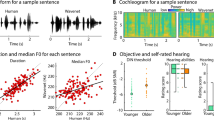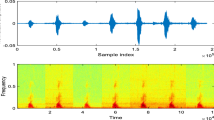ABSTRACT
Won et al. (J Acoust Soc Am 132:1113–1119, 2012) reported that cochlear implant (CI) speech processors generate amplitude-modulation (AM) cues recovered from broadband speech frequency modulation (FM) and that CI users can use these cues for speech identification in quiet. The present study was designed to extend this finding for a wide range of listening conditions, where the original speech cues were severely degraded by manipulating either the acoustic signals or the speech processor. The manipulation of the acoustic signals included the presentation of background noise, simulation of reverberation, and amplitude compression. The manipulation of the speech processor included changing the input dynamic range and the number of channels. For each of these conditions, multiple levels of speech degradation were tested. Speech identification was measured for CI users and compared for stimuli having both AM and FM information (intact condition) or FM information only (FM condition). Each manipulation degraded speech identification performance for both intact and FM conditions. Performance for the intact and FM conditions became similar for stimuli having the most severe degradations. Identification performance generally overlapped for the intact and FM conditions. Moreover, identification performance for the FM condition was better than chance performance even at the maximum level of distortion. Finally, significant correlations were found between speech identification scores for the intact and FM conditions. Altogether, these results suggest that despite poor frequency selectivity, CI users can make efficient use of AM cues recovered from speech FM in difficult listening situations.












Similar content being viewed by others
REFERENCES
ANSI (2002) ANSI S12.60-2002: acoustical performance criteria, design requirements, and guidelines for schools. American National Standards Institute, New York
Armstrong S (1997) GennEm—single channel ACG emulator (version 1.0). Computer software, Burlington
Bilger RC (1977) Electrical stimulation of the auditory nerve and auditory prostheses: a review of the literature. Ann Otol Rhinol Laryngol 86(Suppl 38):11–20
Bingabr M, Espinoza-Varas B, Loizou PC (2008) Simulating the effect of spread of excitation in cochlear implants. Hear Res 241:73–79
Brown GJ, Palomaki KJ (2006) Reverberation. In: Wang D, Brown GJ (eds) Computational auditory scene analysis: principles, algorithms, and applications, Chap.7. Wiley Interscience, Hoboken, pp 209–250
Dorman MF, Dankowski K, McCandless G, Smith LM (1989) Consonant recognition as a function of the number of channels of stimulation by patients who use the Symbion cochlear implant. Ear Hear 10:288–291
Dorman MF, Loizou PC, Rainey D (1997) Speech intelligibility as a function of the number of channels of stimulation for signal processors using sine-wave and noise-band outputs. J Acoust Soc Am 102:2403–2411
Drennan WR, Longnion JK, Ruffin C, Rubinstein JT (2008) Discrimination of Schroeder-phase harmonic complexes by normal-hearing and cochlear-implant listeners. J Assoc Res Otolaryngol 9:138–149
Drennan WR, Ives DT, Won JH, Nie K, Jameyson EM, Anderson ES, Rubinstein JT, Lorenzi C (2013) Perception of frequency-modulation patterns based on recovered-envelope cues for cochlear implant users. Presented at the 36th Annual Midwinter Meeting of the Association of Research in Otolaryngology. Baltimore, MD, USA, February 16–20
Dubbelboer F, Houtgast T (2007) A detailed study on the effects of noise on speech intelligibility. J Acoust Soc Am 122:2865–2871
Fishman K, Shannon RV, Slattery WH (1997) Speech recognition as a function of the number of electrodes used in the SPEAK cochlear implant speech processor. J Speech Hear Res 40:1201–1215
Fourcin AJ, Rosen SM, Moore BCJ et al (1979) External electrical stimulation of the cochlea: clinical, psychophysical, speech perceptual and histological findings. Br J Audiol 13:85–107
Friesen LM, Shannon RV, Baskent D, Wang X (2001) Speech recognition in noise as a function of the number of spectral channels: comparison of acoustic hearing and cochlear implants. J Acoust Soc Am 110:1150–1163
Fu Q-J, Nogaki G (2005) Noise susceptibility of cochlear implant users: the role of spectral resolution and smearing. J Assoc Res Otolaryngol 6:19–27
Fu Q-J, Shannon RV, Wang X (1998) Effects of noise and spectral resolution on vowel and consonant recognition: acoustic and electric hearing. J Acoust Soc Am 104:3586–3596
Gelfand SA (2009) Speech audiometry. In: Essentials of audiology, 3rd edn. Thieme, New York, p 256
Ghitza O (2001) On the upper cutoff frequency of the auditory critical-band envelope detectors in the context of speech perception. J Acoust Soc Am 110:1628–1640
Gilbert G, Lorenzi C (2006) The ability of listeners to use recovered envelope cues from speech fine structure. J Acoust Soc Am 119:2438–2444
Gnansia D, Pressnitzer D, Pean V, Meyer B, Lorenzi C (2010) Intelligibility of interrupted and interleaved speech in normal-hearing listeners and cochlear implantees. Hear Res 14:46–53
Heinz MG, Swaminathan J (2009) Quantifying envelope and fine-structure coding in auditory nerve responses to Chimaeric speech. J Assoc Res Otolaryngol 10:407–423
Hopkins K, Moore BCJ, Stone MA (2010) The effects of the addition of low-level, low-noise noise on the intelligibility of sentences processed to remove temporal envelope information. J Acoust Soc Am 128:2150–2161
Jenstad LM, Souza PE (2005) Quantifying the effect of compression hearing aid release time on speech acoustics and intelligibility. J Speech Lang Hear Res 48:651–667
Jenstad LM, Souza PE (2007) Temporal envelope changes of compression and speech rate: combined effects on recognition for older adults. J Speech Lang Hear Res 50:1123–1138
Kokkinakis K, Loizou PC (2011) The impact of reverberant self masking and overlap- masking effects on speech intelligibility by cochlear implant listeners. J Acoust Soc Am 130:1099–1102
Kokkinakis K, Hazrati O, Loizou PC (2011) A channel-selection criterion for suppressing reverberation in cochlear implants. J Acoust Soc Am 129:3221–3232
Loizou PC, Dorman M, Tu Z (1999) On the number of channels needed to understand speech. J Acoust Soc Am 106:2097–2103
Lorenzi C, Gilbert G, Carn H, Garnier S, Moore BCJ (2006) Speech perception problems of the hearing impaired reflect inability to use temporal fine structure. Proc Natl Acad Sci U S A 103:18866–18869
Lorenzi C, Wallaert N, Gnansia D, Léger A, Ives DT, Chays A, Garnier S, Cazals Y (2012) Temporal-envelope reconstruction for hearing-impaired listeners. J Assoc Res Otolaryngol 13:853–865
McGovern SG (2003) A model for room acoustics. [computer program]. http://www.sgm-audio.com/research/rir/rir.html. Accessed 30 Jan 2014
Moore BCJ (2012) An introduction to the psychology of hearing, 6th edn. Emerald Group Publishing Limited, Bingley, p 145
Moore BCJ, Sek A (1996) Detection of frequency modulation at low modulation rates: evidence for a mechanism based on phase locking. J Acoust Soc Am 100:2320–2331
Patterson RD, Nimmo-Smith I, Holdsworth J, Rice P (1987) An efficient auditory filterbank based on the gammatone function. In: Paper Presented at a Meeting of the IOC Speech Group on Auditory Modeling at RSRE, December 14–15
Peterson GE, Lehiste I (1962) Revised CNC lists for auditory tests. J Speech Hear Disord 27:62–70
Plomp R (1988) The negative effect of amplitude compression in multichannel hearing aids in the light of the modulation-transfer function. J Acoust Soc Am 83:2322–2327
Poissant SF, Whitmal NA, Freyman RL (2006) Effects of reverberation and masking on speech intelligibility in cochlear implant simulations. J Acoust Soc Am 119:1606–1615
Qin MK, Oxenham AJ (2003) Effects of simulated cochlear implant processing on speech reception in fluctuating maskers. J Acoust Soc Am 114:446–454
Saberi K, Hafter ER (1995) A common neural code for frequency and amplitude modulated sounds. Nature 374:537–539
Shannon RV, Jensvold A, Padilla M, Robert ME, Wang X (1999) Consonant recordings for speech testing. J Acoust Soc Am 106:L71–L74
Sheft S, Ardoint M, Lorenzi C (2008) Speech identification based on temporal fine structure cues. J Acoust Soc Am 124:562–575
Smith ZM, Delgutte B, Oxenham AJ (2002) Chimaeric sounds reveal dichotomies in auditory perception. Nature 416:87–90
Souza PE, Jenstad LM, Boike KT (2006) Measuring the acoustic effects of compression amplification on speech in noise. J Acoust Soc Am 119:41–44
Spahr AJ, Dorman MF, Loiselle LH (2007) Performance of patients using different cochlear implant systems: effects of input dynamic range. Ear Hear 28:260–275
Steeneken HJ, Houtgast T (1980) A physical method for measuring speech-transmission quality. J Acoust Soc Am 67:318–326
Stickney GS, Nie K, Zeng F-G (2005) Contribution of frequency modulation to speech recognition in noise. J Acoust Soc Am 118:2412–2420
Strydom T, Hanekom JJ (2011) An analysis of the effects of electrical field interaction with an acoustic model of cochlear implants. J Acoust Soc Am 129:2213–2226
Studebaker GA (1985) A rationalized arcsine transform. J Speech Hear Res 28:455–462
Swaminathan J, Heinz MG (2012) Psychophysiological analyses demonstrate the importance of neural envelope coding for speech perception in noise. J Neurosci 32:1747–1756
Tillery KH, Brown CA, Bacon SP (2012) Comparing the effects of reverberation and of noise on speech recognition in simulated electric-acoustic listening. J Acoust Soc Am 131:416–423
Torick EL, Keller TB (1985) Improving the signal-to-noise ratio and coverage of FM stereophonic broadcasts. J Audio Eng Soc 33:938–943
Verschuur C (2009) Modeling the effect of channel number and interaction on consonant recognition in a cochlear implant peak-picking strategy. J Acoust Soc Am 125:1723–1736
White HE, White DH (1980) Physics and music: the science of musical sound. Saunders College Publication, Philadelphia, p 375
Whitmal NA, Poissant SF (2009) Effects of source-to-listener distance and masking on perception of cochlear implant processed speech in reverberant rooms. J Acoust Soc Am 126:2556–2569
Wilson BS, Dorman MF (2008) Cochlear implants: a remarkable past and a brilliant future. Hear Res 242:3–21
Won JH, Drennan WR, Rubinstein JT (2007) Spectral-ripple resolution correlates with speech reception in noise in cochlear implant users. J Assoc Res Otolaryngol 8:384–392
Won JH, Lorenzi C, Nie K, Li X, Jameyson EM, Drennan WR, Rubinstein JT (2012) The ability of cochlear implant users to use temporal envelope cues recovered from speech frequency modulation. J Acoust Soc Am 132:1113–1119
Zeng FG (2004) Compression and cochlear implants. In: Compression: from cochlear to cochlear implants, vol 17. Springer Handbook of Auditory Research, New York, pp 184–220
Zeng FG, Grant G, Niparko J, Galvin J, Shannon R, Opie J, Segel P (2002) Speech dynamic range and its effect on cochlear implant performance. J Acoust Soc Am 111:377–386
Zeng FG, Nie K, Stickney GS, Kong YY, Vongphoe M, Bhargave A, Wei C, Cao K (2005) Speech recognition with amplitude and frequency modulations. Proc Natl Acad Sci U S A 102:2293–2298
Zheng Y, Koehnke J, Besing J, Spitzer J (2011) Effects of noise and reverberation on virtual sound localization for listeners with bilateral cochlear implants. Ear Hear 32:569–572
Zwicker E (1962) Direct comparisons between the sensations produced by frequency modulation and amplitude modulation. J Acoust Soc Am 34:1425–1430
ACKNOWLEDGEMENTS
We are grateful for the dedicated efforts of our CI subjects. This research was supported by NIH-NIDCD Grants R01-DC007525, P30-DC04661, and an educational fellowship from the Advanced Bionics Corporation. Hyun Joon Shim was supported by Eulji Medical Center, Korea. Christian Lorenzi was supported by a visiting scholarship awarded by the Virginia Merrill Bloedel Hearing Research Center. Christian Lorenzi was also supported by three grants from ANR: HEARFIN project, ANR-11-0001-02 PSL, and ANR-10-LABX-0087.
Author information
Authors and Affiliations
Corresponding author
Rights and permissions
About this article
Cite this article
Won, J.H., Shim, H.J., Lorenzi, C. et al. Use of Amplitude Modulation Cues Recovered from Frequency Modulation for Cochlear Implant Users When Original Speech Cues Are Severely Degraded. JARO 15, 423–439 (2014). https://doi.org/10.1007/s10162-014-0444-1
Received:
Accepted:
Published:
Issue Date:
DOI: https://doi.org/10.1007/s10162-014-0444-1




